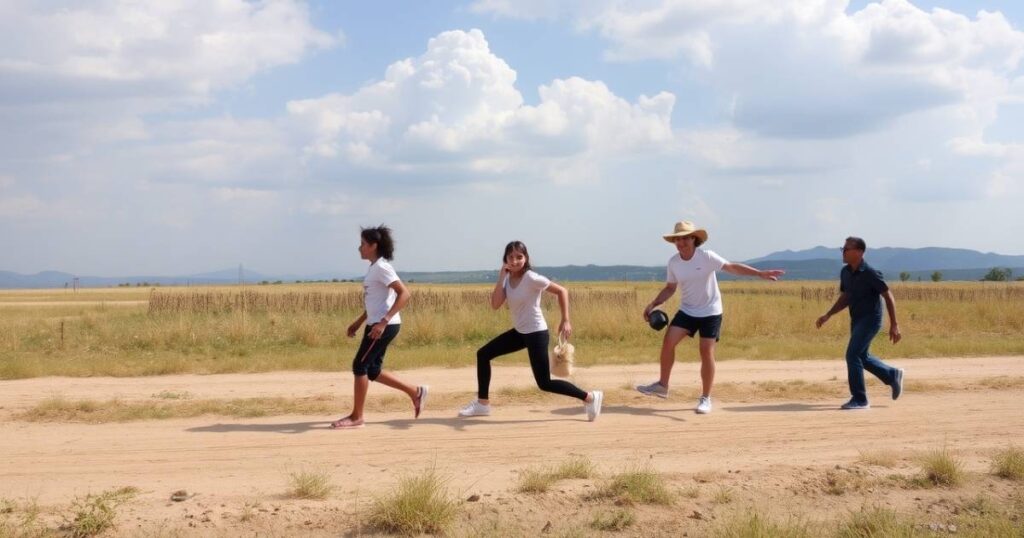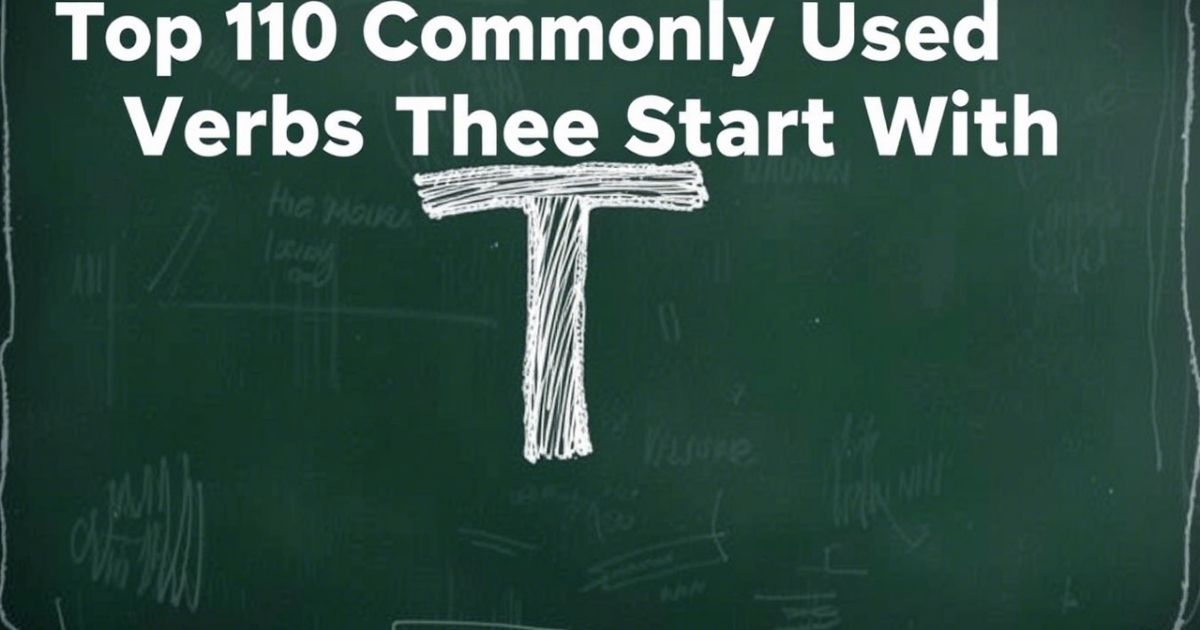Verbs That Start with T are an exciting group of action words that can add variety and precision to your language. Whether you’re describing actions, processes, or decisions, verbs that start with t can make your sentences more dynamic. These verbs starting with t cover a wide range of meanings, from physical actions to emotional responses. By incorporating verbs with t into your vocabulary, you can express yourself more clearly and effectively. Exploring verbs that start with t will not only improve your language skills but also help you better articulate ideas in different contexts.
When learning about verbs that start with t, it’s important to know the variety of options available. From common t verbs like “take” and “talk” to more complex ones like “tinker” or “target,” verbs starting with t can make your communication more engaging. Experimenting with verbs that start with t will help expand your linguistic toolbox and elevate your writing and speaking. So, dive into the world of verbs with t and start using them in your daily conversations!
Movement and Physical Actions

These verbs are essential for describing various forms of movement and physical actions. They capture the dynamic nature of how individuals and objects interact with their surroundings. Whether it’s through walking, running, or even using force, these verbs that start with T provide vivid imagery and help convey action.
- Take: To move something from one place to another.
Example: She took the book off the shelf and placed it on the table. - Tackle: To engage in a physical challenge, often involving force or determination.
Example: He tackled the difficult task with confidence. - Tear: To rip or damage something through forceful movement.
Example: She tore the paper in frustration after the mistake. - Thrust: To push something with a strong, sudden movement.
Example: He thrust the door open to reveal the surprise. - Tumble: To fall or roll in an uncontrolled manner, often resulting in a loss of balance.
Example: The child tumbled down the hill, laughing the whole way. - Trample: To step heavily or forcefully on something, often causing harm.
Example: The crowd trampled over the flowers during the concert. - Turn: To rotate or move in a circular motion.
Example: She turned the knob to unlock the door. - Twist: To rotate or bend something into a new shape, often with force.
Example: He twisted the cap off the bottle with ease. - Trick: To deceive or perform an action cleverly to mislead someone.
Example: The magician tricked the audience with his amazing sleight of hand. - Trot: To run at a moderate, controlled pace, often used in reference to horses.
Example: The horse trotted gracefully around the ring. - Tiptoe: To walk quietly and carefully, often on the tips of your toes.
Example: She tiptoed into the room to avoid waking anyone. - Throb: To beat or pulse with rhythmic force, typically referring to the heart or a physical sensation.
Example: Her head throbbed after the long day in the sun. - Tug: To pull something sharply or suddenly.
Example: He tugged at the rope to bring the boat closer. - Tilt: To move or shift something to a slanted or angled position.
Example: She tilted her head in curiosity when she heard the strange noise. - Tread: To step carefully or gently, often to avoid making noise or disturbing something.
Example: He tread softly on the wet ground to avoid leaving tracks. - Take off: To leave the ground, typically in reference to airplanes or other flying objects.
Example: The plane took off smoothly into the clear blue sky. - Thrust: To push or drive forward with force, often in a swift motion.
Example: He thrust his arm out to stop the car from rolling downhill.
Communication and Expression
These verbs are essential for communication and expression, enabling individuals to convey thoughts, ideas, emotions, and intentions. Whether through speaking, writing, or nonverbal cues, these verbs that start with T help articulate messages clearly and effectively.
- Transcribe: To make a written or typed copy of spoken material.
Example: She transcribed the meeting minutes so everyone could review them. - Talk: To speak in order to share information or express thoughts.
Example: We talk about our favorite books every weekend. - Tell: To inform or explain something to someone.
Example: He told me all about his trip to the mountains. - Tattle: To report something, usually a secret or wrongdoing, to others.
Example: She tattled on her brother for sneaking candy before dinner. - Text: To send a written message, usually through a mobile phone or computer.
Example: I’ll text you the address for the party later. - Tattle: To tell on someone or reveal information, often in a negative light.
Example: He tattled on his classmate for cheating during the test. - Translate: To express the meaning of words or text in another language.
Example: She translated the letter from French to English for her friend. - Tear: To break apart or distort something, often in a dramatic or emotional context.
Example: His words tore at my heart during the difficult conversation. - Transmit: To send information or signals from one place to another.
Example: The news was transmitted live to millions of viewers. - Tease: To make fun of or provoke someone in a playful or teasing manner.
Example: He teased her about her new hairstyle, but she took it in good humor.
Related Guide:
Top 105 Commonly Used Verbs That Start With V [2025]
Mental and Emotional States
These verbs are essential for describing mental and emotional states, allowing us to capture the intricacies of how people think, feel, and experience the world around them. They enable the expression of internal states, providing insight into the emotional and psychological aspects of human experience, using verbs that start with T to convey those complex emotions and thoughts more vividly.
- Think: To engage in thought, consider, or reflect on something.
Example: She thought about the decision carefully before making up her mind. - Talk: To express one’s thoughts or emotions through speech.
Example: He talks about his dreams and aspirations with such passion. - Tremble: To shake involuntarily, often due to fear, anxiety, or excitement.
Example: Her hands trembled when she opened the envelope with the news. - Tolerate: To endure or accept something difficult or unpleasant.
Example: He tolerated the harsh conditions for the sake of his family. - Thrill: To feel intense excitement or pleasure.
Example: The rollercoaster ride thrilled her beyond words. - Tire: To feel exhaustion or fatigue from physical or mental effort.
Example: His long work hours began to tire him, but he pushed through. - Tangle: To become confused or mixed up, often mentally or emotionally.
Example: She tangled her thoughts when trying to solve the complicated problem. - Tremble: To experience a physical reaction due to strong emotions, like fear or excitement.
Example: He trembled with anticipation as he awaited the big announcement. - Tear: To feel profound sorrow or grief, often resulting in crying.
Example: She tore up with emotion during the farewell speech. - Tease: To provoke or annoy someone in a playful way, often affecting their emotional state.
Example: Her friends teased her about her nervousness, making her blush. - Twinge: To experience a sudden, sharp feeling of discomfort, often emotional or physical.
Example: She felt a twinge of guilt after the argument with her best friend. - Tranquilize: To calm or soothe someone emotionally, often by calming their anxiety.
Example: The peaceful music seemed to tranquilize her after a long day. - Torture: To experience intense emotional pain or distress, often from inner conflict.
Example: The memories of the past continued to torture him for years. - Twist: To feel a distortion in one’s emotions, often due to confusion or conflicting feelings.
Example: His heart twisted with regret after the harsh words he had said. - Tug: To feel a strong emotional pull or attachment toward someone or something.
Example: A feeling of nostalgia tugged at her heart as she revisited her childhood home.
Control and Management
These verbs are crucial for describing control and management actions, offering insight into how individuals or groups direct, oversee, or regulate various situations, tasks, or systems. They are essential in leadership, decision-making, and organizational contexts, with verbs that start with T playing a key role in expressing these management actions.
- Take: To assume responsibility for something or someone, often involving control or management.
Example: She took charge of the project to ensure it was completed on time. - Tackle: To address or deal with a challenge, problem, or task, often requiring focus and management.
Example: He tackled the financial issues head-on and created a solution. - Tame: To bring under control, usually referring to wild animals or unruly situations.
Example: The trainer tamed the wild horse through patience and skill. - Target: To aim or direct efforts toward a specific goal or outcome.
Example: The team targeted the new market segment for their next campaign. - Tighten: To make something more secure or controlled, often used metaphorically for regulations or rules.
Example: The government tightened control over the banking system after the crisis. - Tear: To disrupt or break down a system or plan, usually with consequences to control.
Example: The unexpected resignation of the CEO tore apart the company’s structure. - Turn: To redirect or shift focus to a new direction, often in management or leadership.
Example: The manager turned the discussion towards a more productive strategy. - Track: To monitor or keep a record of progress or movement, often to maintain control.
Example: She tracked the project milestones to ensure the team stayed on schedule. - Trim: To reduce or manage something by cutting back unnecessary elements.
Example: The company trimmed the budget to meet its financial goals. - Tweak: To make small adjustments or improvements, often to refine or optimize a process.
Example: He tweaked the marketing plan to increase engagement with customers. - Tolerate: To allow something to continue without interference, often implying control over one’s reactions.
Example: The manager tolerated minor mistakes but expected improvement over time. - Transfer: To move responsibility or control from one person or group to another.
Example: The company transferred leadership of the project to a new team leader. - Tidy: To organize or arrange things in a controlled and efficient manner.
Example: She tidied up the office to create a more productive work environment. - Teach: To impart knowledge or skills, often involving control over how information is presented or learned.
Example: The supervisor taught the new hires how to manage the software effectively. - Test: To assess or evaluate something for effectiveness, often to determine if management strategies are working.
Example: The team tested various solutions to find the best approach to the problem.
Creation and Transformation

These verbs are vital for expressing creation and transformation, capturing the processes through which something is made, altered, or evolved. They encompass the act of bringing new things into existence or changing something into a new form, allowing for dynamic descriptions of both creative and transformative actions, especially with verbs that start with T.
- Take: To begin or initiate something, often with the aim of creating or starting a process.
Example: She took the first step in creating her own business. - Tear: To destroy or rip something, often as part of a transformative action.
Example: The artist tore pieces of paper to create a textured collage. - Transform: To change something completely in form, appearance, or character.
Example: The old factory was transformed into a modern art gallery. - Tangle: To mix or twist things together, often resulting in a new form or structure.
Example: She tangled the yarn into a beautiful, intricate design. - Twist: To change the shape or form of something by turning it, often leading to a new creation or transformation.
Example: The director twisted the plot to create an unexpected ending. - Tinker: To make small adjustments or experiments in order to improve or change something.
Example: He spent hours tinkering with his invention to make it work better. - Turn: To change something’s direction or form, often involving a shift in purpose or character.
Example: She turned her hobby into a successful career. - Tear: To break something apart or alter it dramatically, often leading to change.
Example: The breakup tore apart their shared vision for the future. - Tackle: To approach or take on something challenging, often involving the creation of a solution.
Example: He tackled the new software project with innovative ideas. - Tame: To change or control something wild or untamed, bringing it into a more manageable form.
Example: Over time, the gardener tamed the wild garden into a beautiful, ordered space. - Trick: To deceive or manipulate in a way that causes a change in perception or reality.
Example: The magician tricked the audience by transforming a simple object into something extraordinary. - Target: To aim at a specific goal, which can involve the creation of a new project or vision.
Example: The company targeted a new market, transforming its business strategy. - Tweak: To make minor adjustments or changes, often to improve or refine something.
Example: He tweaked the design to make it more functional. - Tease: To provoke or subtly transform someone’s expectations or emotional state.
Example: The teaser for the movie transformed expectations with a dramatic plot reveal. - Take off: To begin to succeed or develop rapidly, often involving a transformation in scale or importance.
Example: Her startup took off after the first year, expanding into new markets.
Observation and Perception
These verbs are crucial for describing observation and perception, allowing individuals to convey how they notice, interpret, and understand the world around them. They capture the process of perceiving details, making sense of experiences, and reflecting on what is seen, heard, or felt, with verbs that start with T enhancing these descriptions.
- Take: To notice or observe something carefully.
Example: She took in the beautiful scenery as the sun set over the ocean. - Tackle: To address or engage with a challenge, often after observing it.
Example: He tackled the problem after observing its impact on the team. - Target: To focus attention or observation on a specific object or goal.
Example: The scientist targeted the rare species for closer observation during the expedition. - Twinge: To experience a sharp, momentary sensation, often in response to something perceived.
Example: I felt a twinge of regret after noticing how I had reacted to her comment. - Tease: To provoke or pull someone’s attention, often in a playful or teasing manner.
Example: The flickering light teased my attention, making it hard to focus. - Twist: To perceive or interpret something in a different way, often changing its meaning.
Example: She twisted his words, perceiving them as criticism when he meant them as praise. - Track: To follow or observe something carefully over time.
Example: The team tracked the progress of the project, observing any delays. - Tingle: To feel a physical or emotional sensation as a result of something perceived.
Example: I felt a tingle of excitement as I watched the performance unfold. - Tear: To break down or dissect an observation or perception, often to better understand it.
Example: He tore apart the argument after carefully observing the logic behind it. - Tease: To draw attention to something without fully revealing it, keeping others guessing.
Example: The preview teaser teased the audience, leaving them eager to know more. - Trick: To mislead or alter someone’s perception, often through deception.
Example: The optical illusion tricked my eyes, making the image seem to move. - Turn: To shift one’s attention or focus, often changing the way something is perceived.
Example: After a few seconds of observing, I turned my attention to the more pressing issue. - Tangle: To become confused or caught in a misperception, often due to mixed signals.
Example: His thoughts tangled as he tried to make sense of the conflicting information. - Tolerate: To endure or accept something perceived, often with difficulty.
Example: She tolerated the loud noises during the festival, despite finding them distracting. - Tweak: To adjust or change an observation slightly for a better or clearer perception.
Example: After tweaking the settings, I could finally see the details in the image clearly.
Problem Solving and Decision Making

These verbs are integral to problem solving and decision making, describing the actions individuals take to analyze, address, and resolve issues. They capture the dynamic process of evaluating options, choosing a course of action, and implementing solutions, with verbs that start with T playing a key role in this process.
- Take: To make a decision or choose a course of action.
Example: She took responsibility for solving the issue after considering all the possible solutions. - Tackle: To approach and deal with a problem, often head-on.
Example: The team tackled the project delays by developing a more efficient plan. - Target: To focus on a specific issue or problem that needs to be solved.
Example: The company targeted the root cause of the inefficiency to improve productivity. - Think: To engage in careful consideration or reflection before making a decision.
Example: He thought carefully about the possible outcomes before deciding on the best approach. - Test: To experiment or trial solutions in order to evaluate their effectiveness.
Example: They tested the new system on a small scale before full implementation. - Turn: To shift attention to another aspect of the problem to find a solution.
Example: After considering the first option, they turned to a more practical solution. - Trim: To reduce or eliminate unnecessary elements in order to simplify a decision-making process.
Example: They trimmed down the list of options to only the most viable solutions. - Tackle: To confront a challenge or problem with a proactive attitude.
Example: The manager tackled the customer complaints with a clear and structured plan. - Tease: To gently explore different ideas or solutions before settling on one.
Example: She teased out a few possible solutions during the brainstorming session. - Test: To validate assumptions or solutions through trial or experiment.
Example: The engineer tested various designs to determine which would work best. - Take off: To start or initiate a project or decision-making process.
Example: Once the decision was made, the plan took off quickly and efficiently. - Tweak: To make small changes or adjustments in order to improve a decision or solution.
Example: He tweaked the proposal to address some of the concerns raised by the team. - Turnaround: To change a negative situation into a more favorable one.
Example: The company managed a quick turnaround by implementing strategic changes. - Tangle: To become involved in confusion or complexity, making the problem harder to solve.
Example: The team got tangled in details, making it difficult to move forward with a decision. - Target: To set a clear objective or goal, focusing efforts on resolving the problem.
Example: The project manager targeted the main issue and worked to resolve it as a priority.
FAQ’s
What are some common action words starting with T?
There are many verbs that start with T, like talk, take, and target. These words help describe a wide range of actions.
How can I improve my language skills with action words?
Using verbs that start with T can enhance your vocabulary and communication. These words can add clarity and precision to your everyday conversations.
Why should I use more verbs in my writing?
Incorporating verbs that start with T in your writing can make your sentences more dynamic. This helps convey your message more effectively and vividly.
How do verbs help in expressing emotions or actions?
Verbs that start with T describe both emotional and physical actions. They help capture the mood and activity in a clear, engaging way.
How can I make my speaking more engaging?
Adding verbs that start with T to your vocabulary will make your speech more interesting. It allows you to express thoughts with greater variety.
Conclusion
verbs that start with t are a valuable part of the English language. These verbs starting with t can help add variety and clarity to your communication. By using verbs with t, you can make your sentences more precise and engaging. Whether you’re talking about actions, emotions, or decisions, verbs that start with t give you the right words to express yourself clearly. Mastering these t verbs will allow you to speak and write with more confidence and creativity.
So, if you’re looking to expand your vocabulary, focusing on verbs that start with t is a great place to begin. By practicing and incorporating verbs starting with t into your everyday conversations, you’ll improve both your speaking and writing skills. There are countless verbs that start with t, each with its unique meaning and usage. Exploring verbs with t will undoubtedly enhance your ability to communicate more effectively.

Zion Blaze is a dedicated administrator with 5 years of experience in managing operations, optimizing workflows, and ensuring efficiency. Skilled in leadership, problem-solving, and team coordination.

